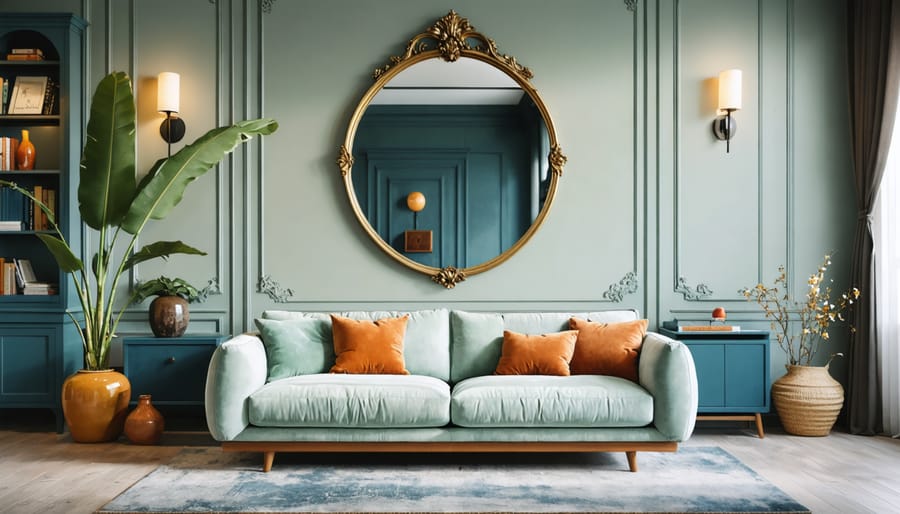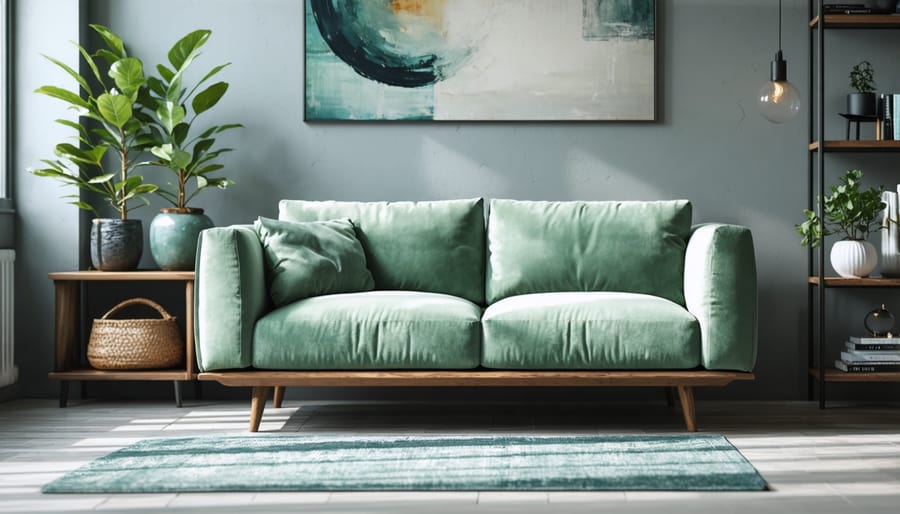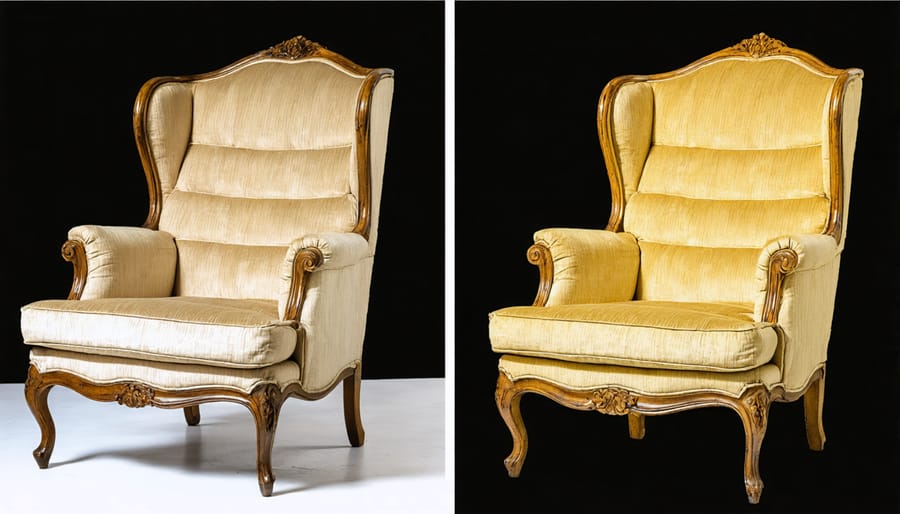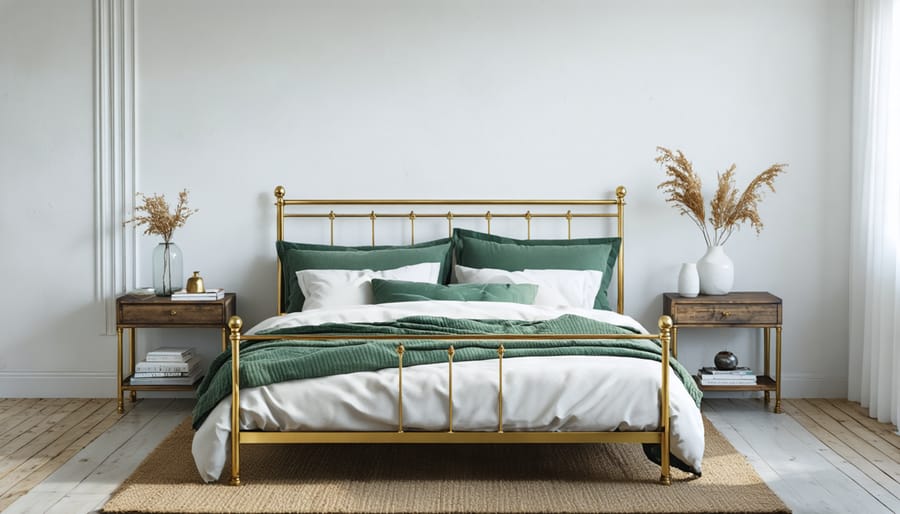
Transform your living space into a sophisticated blend of eras by pairing weathered antiques with sleek contemporary pieces. Select vintage furniture with clean lines and classic proportions, then complement them with modern metallic accents and minimalist artwork. Incorporate a nature-inspired design approach by mixing organic materials like reclaimed wood and aged brass with current design elements such as geometric patterns and smart lighting solutions. Balance authenticity with functionality by restoring period pieces to maintain their character while updating their utility – think Victorian armchairs reupholstered in modern performance fabrics or Art Deco sideboards retrofitted with current hardware. Modern vintage style isn’t about recreating the past; it’s about curating a thoughtful collection that honors historical craftsmanship while embracing contemporary comfort and convenience.
Modern vintage decor artfully blends the charm of bygone eras with contemporary design elements, creating spaces that feel both timeless and fresh. This style typically incorporates authentic vintage pieces from the 1920s through the 1970s alongside modern furnishings and accessories. The key is achieving a deliberate balance – mixing period furniture with clean-lined contemporary pieces while avoiding a museum-like or cluttered appearance.
What sets modern vintage apart is its selective approach to incorporating historical elements. Rather than recreating a specific era wholesale, this style cherry-picks standout vintage pieces and pairs them with current design trends. Think of a mid-century modern credenza serving as a media console, or Victorian wingback chairs reupholstered in bold, contemporary fabrics.
Characteristic elements include original architectural details, vintage furniture with patina, antique mirrors and artwork, and heritage lighting fixtures. These classic pieces are then complemented by modern color schemes, updated textiles, and current technology integration. The result is a sophisticated, personalized space that tells a story while remaining thoroughly functional for today’s lifestyle.

Creating a harmonious color palette that bridges vintage charm with modern sensibilities is essential for achieving a successful modern vintage aesthetic. Start with a foundation of timeless neutrals like warm cream, soft gray, or gentle taupe, which serve as versatile backdrops for both contemporary and antique pieces. These base colors can be enhanced by incorporating deeper, more dramatic hues that were popular in different eras, such as rich emerald green, deep navy, or burgundy.
Modern elements can be introduced through contemporary color accents like blush pink, sage green, or muted gold, while incorporating organic textures and natural materials helps ground the space. Consider using the 60-30-10 rule: 60% dominant color (usually your neutral base), 30% secondary color (your vintage-inspired hue), and 10% accent color (your modern pop).
For a cohesive look, try pulling colors from vintage artwork or textiles and reinterpreting them in contemporary ways, such as using a muted version of a bold vintage pattern or incorporating classic colors through modern geometric designs. This thoughtful approach to color creates spaces that feel both timeless and fresh.
Selecting statement vintage furniture pieces is a crucial step in creating a modern vintage aesthetic that feels both authentic and purposeful. When choosing these cornerstone pieces, focus on items that showcase distinctive craftsmanship and design elements characteristic of their era. Mid-century modern sideboards, Victorian armchairs, or Art Deco vanities can serve as striking focal points that anchor your space.
Look for pieces with strong architectural elements or unique details that catch the eye – perhaps a curved wingback chair with original upholstery or a solid wood dresser with intricate inlay work. The key is to select items that tell a story while maintaining functionality in your modern space.
Consider scale carefully when selecting statement pieces. A large vintage cabinet might work beautifully in a spacious living room but could overwhelm a modest apartment. Similarly, pay attention to the piece’s condition – while some patina adds character, structural integrity is essential for furniture that will see daily use.
When incorporating these pieces into your modern setting, create breathing space around them. Allow vintage furniture to stand out by pairing it with contemporary pieces in complementary colors and simpler designs. This contrast helps highlight the vintage piece’s unique characteristics while maintaining a balanced, livable space.
For maximum impact, limit yourself to one or two statement pieces per room. This approach prevents the space from feeling like a cluttered antique store and ensures each vintage piece receives the attention it deserves.
Modern accents play a crucial role in preventing vintage-inspired spaces from feeling like time capsules. The key is to create a thoughtful balance between old and new elements. Start by incorporating contemporary lighting fixtures, such as sleek pendant lights or modern floor lamps, which can instantly update the feel of a room while complementing vintage furniture pieces.
Metal finishes are excellent modern accents – consider matte black or brushed gold hardware to update vintage dressers or cabinets. Abstract art pieces or large-scale contemporary photographs can create striking contrasts when paired with antique frames or vintage furniture arrangements.
For textiles, mix traditional patterns with contemporary fabrics. Layer a vintage Persian rug with modern geometric throw pillows, or pair antique upholstered chairs with crisp, solid-colored linens. Modern technological elements can be tastefully integrated using vintage-style covers or creative placement within antique furniture pieces.
Minimalist accessories like simple ceramic vases, metallic sculptures, or clean-lined mirrors help create visual breathing space around more ornate vintage pieces. When selecting modern accents, stick to a cohesive color palette that complements your vintage items while maintaining a fresh, current feel.
Remember that modern accents should enhance, not overshadow, your vintage pieces. The goal is to create a curated look that feels both timeless and contemporary, showing that good design transcends any single era.
The art of mixing materials and textures is crucial in achieving a successful modern vintage aesthetic. Start by establishing a foundation with classic materials like wood and metal, then layer in unexpected combinations to create visual interest. Consider pairing weathered leather chairs with sleek glass tables, or rustic wooden pieces with polished chrome accents.
Incorporating natural elements into your decor adds depth and authenticity to your space. Mix rough-hewn wooden beams with smooth marble surfaces, or combine distressed vintage furniture with modern velvet upholstery. The key is to maintain balance – for every rough texture, introduce a smooth counterpart.
When selecting pieces, focus on contrasts that complement rather than clash. A vintage brass lamp can beautifully offset modern matte ceramics, while antique wool rugs can ground contemporary leather furniture. Consider incorporating industrial elements like exposed brick or metal fixtures alongside softer elements such as woven textiles or plush fabrics.
Remember to maintain coherence through color palette and scale. Even dramatically different textures can work harmoniously when united by complementary tones. Start small with accent pieces and gradually build your material mix as you become more confident in your styling choices. This thoughtful layering of textures and materials creates a space that feels both curated and organically evolved.
When incorporating vintage pieces into your modern decor, deciding whether to restore or replace an item can significantly impact both your space’s aesthetic and your budget. The key lies in evaluating several crucial factors before making your decision.
First, assess the piece’s structural integrity. If the basic framework is sound and the item maintains its functionality, restoration is often worth considering. However, if there’s extensive damage to load-bearing elements or signs of irreparable wood rot, replacement might be more practical.
Consider the item’s historical and emotional value. Family heirlooms or pieces from significant design periods often merit restoration, even at a higher cost. The unique character and craftsmanship of vintage pieces can add irreplaceable charm to your modern space.
Evaluate the restoration costs against replacement value. As a general rule, if restoration exceeds 70% of the cost of a comparable quality new piece, replacement might be more economical. However, this guideline shifts if the item is rare or holds special significance.
Look for quality markers such as solid wood construction, dovetail joints, and high-grade materials. These features often indicate pieces worth restoring. Simple cosmetic issues like scratches, worn finish, or outdated hardware are typically straightforward and cost-effective to address.
Remember that some imperfections add character and authenticity to vintage pieces. Minor wear can enhance the contrast with modern elements, creating that desired blend of old and new in your space.

Preserving vintage furniture requires consistent care and attention to maintain its character while ensuring longevity. Start by placing pieces away from direct sunlight to prevent fading and wood deterioration. Maintain stable room temperature and humidity levels, as extreme fluctuations can cause wood to warp or veneer to peel.
Regular dusting with a soft, lint-free cloth is essential. Avoid using standard furniture polish on antique pieces; instead, opt for a high-quality beeswax polish applied every 6-12 months. For daily cleaning, a slightly damp cloth followed by immediate drying works best.
Address scratches and marks promptly to prevent further damage. Minor scratches can often be concealed using a matching wood marker or walnut meat. For deeper scratches or structural issues, consult a professional restoration expert.
When moving vintage pieces, always lift from the base rather than pulling by handles or decorative elements. Use felt pads under legs to protect both the furniture and flooring. For upholstered items, vacuum regularly using a soft brush attachment and address stains immediately with appropriate cleaners.
Store unused pieces in climate-controlled environments, covered with breathable cotton sheets rather than plastic. Regularly inspect for signs of wood-boring insects or moisture damage, particularly in joints and crevices. Quick identification of potential issues can prevent costly repairs and preserve your vintage furniture’s value and beauty.
Living spaces present the perfect canvas for showcasing the modern vintage aesthetic, where carefully curated pieces tell a story while maintaining contemporary functionality. Start by selecting a statement vintage piece, such as a mid-century modern sofa or an antique armoire, to serve as your room’s focal point. Balance this with clean-lined modern furniture, creating an intentional contrast that defines the style.
Layer your space with thoughtful vintage accents like restored table lamps, classic artwork, or traditionally crafted side tables. These pieces can be beautifully complemented by incorporating biophilic design elements through indoor plants and natural materials, bridging the gap between old and new.
Consider implementing a neutral color palette as your base, allowing vintage pieces to shine while maintaining a contemporary feel. Textiles play a crucial role – mix modern geometric patterns with vintage-inspired fabrics, such as velvet or brocade, to add depth and interest. Original hardwood floors, when properly restored, can provide an authentic foundation while complementing both modern and vintage elements.
Remember to leave breathing room between pieces – overcrowding can make vintage items feel cluttered rather than curated. Strategic placement of mirrors and lighting fixtures can help create a sense of space while highlighting your carefully selected vintage treasures.
Bedrooms and personal spaces offer the perfect canvas for expressing your unique modern vintage style while creating a cozy, intimate atmosphere. Start by selecting a vintage bed frame as your room’s centerpiece – brass, iron, or carved wooden frames work beautifully when paired with crisp, contemporary bedding in solid colors or subtle patterns.
Incorporate vintage dressers or armoires, restored to their original glory, alongside modern nightstands for an intentional style contrast. Consider refinishing vintage pieces in modern colors while maintaining their original hardware to bridge the old and new aesthetics. Lighting plays a crucial role – pair restored vintage table lamps with modern pendant lights or sleek sconces to create layers of illumination.
For wall decor, create an eclectic gallery wall mixing vintage portraits or botanical prints in ornate frames with modern abstract art in simple frames. Add personality with carefully curated accessories – vintage mirrors, antique perfume bottles, and classic books can sit harmoniously with modern ceramics and metallic accents.
Don’t forget the textiles – layer vintage quilts or throws over modern bedding, and mix antique needlepoint pillows with contemporary cushions. A restored vintage area rug anchors the space while adding warmth and character. The key is maintaining a balance between old and new elements while creating a peaceful retreat that feels both timeless and fresh.

Modern vintage decor style offers a unique opportunity to create spaces that are both timeless and fresh. By thoughtfully combining classic pieces with contemporary elements, you can achieve a personalized look that tells your story while maintaining current design sensibilities. Remember that successful modern vintage design isn’t about following strict rules, but rather about finding the right balance between old and new. Whether you’re starting with family heirlooms or hunting for vintage treasures, focus on quality pieces that speak to you and complement your existing décor. Don’t be afraid to experiment with different eras and styles – the beauty of modern vintage lies in its flexibility and personal interpretation. With proper care and maintenance of your vintage pieces, you’ll create a sophisticated, lived-in atmosphere that never goes out of style.